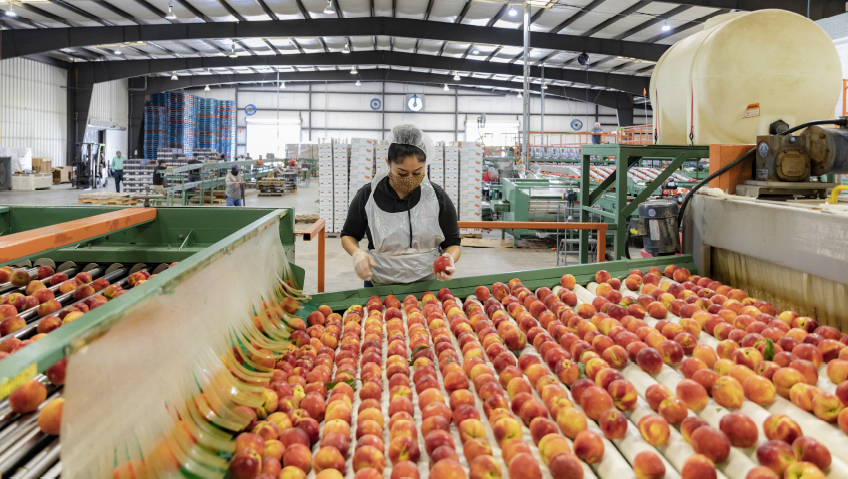Whether served sunny-side up, scrambled, in a fluffy omelet, or as a pancake ingredient, nutrient-rich eggs are a breakfast staple. Meanwhile, poultry makes its debut at lunchtime—featured in soups, salads, sandwiches, or stir-fries—and continues as the star attraction of festive season dinners. But tasty as they are, we ask you to put down that sandwich—egg, chicken, or turkey—and join us for a closer look inside the industry.
According to the United States Department of Agriculture (USDA), poultry producers hold leading positions in both international and U.S. meat commodity markets. The U.S. is the largest poultry producer and the second-largest egg producer in the world, with the industry heavily concentrated in the southeastern states.
In October 2024, the U.S. Poultry & Egg Association, National Chicken Council, National Turkey Federation, and United Egg Producers released an updated economic impact study. The report indicated that the industry provides over two million jobs, $132.7 billion in wages, $663.6 billion in economic activity, and $54 billion in government revenue.
Trade plays a huge role in the sector’s profitability by lowering domestic prices. From 2013 to 2022, 17 percent of domestic broiler production was exported, along with 11 percent of turkey production. Mexico is the largest foreign market for poultry, while the largest markets for egg exports are Mexico and Canada.
Meanwhile, according to Agriculture Canada’s industry profile, in 2023, Canada produced poultry and egg products that contributed $6.8 billion to its GDP, with the largest poultry producers concentrated in Ontario and Quebec. While most of the products are consumed domestically, Canada also exports a variety of poultry products. In 2023, Canada exported breeding stock, hatching eggs, and live birds—turkeys, ducks, and geese—along with other poultry meat and meat products worth $61.8 million to 24 countries. The U.S. was the largest market, accounting for 71 percent of the exports.
Included in these figures were over 3.3 million hatching eggs of different species sent to 19 countries, with the U.S. accounting for 64 percent of the market—over 3 million kilograms of processed eggs worth $15 million and over 24.2 million shell eggs worth over $3.6 million.
Bird Flu – a dark cloud
While there is much to celebrate, a dark cloud looms over the industry in the form of the H5N1 virus, which causes Highly Pathogenic Avian Influenza (HPAI), a disease lethal to poultry with the potential to devastate the industry and significantly affect food security.
Carried by migrating wild birds, this virus, which has been recognized since the late 1800s, has mutated and spread globally. Spring and fall, when birds migrate, are the optimal seasons for bird flu outbreaks.
In North America, the virus was first detected in a U.S. commercial flock on February 8, 2022, and was later found in flocks across Canada, Latin America, and the Caribbean that same year. While the virus is not harmful to humans in thoroughly cooked poultry, it is lethal to the animals and has been shown to be transmissible to farm workers, which could lead to a serious public health issue. For this reason, millions of birds in North America have been culled in the last two years.
To mitigate the risk of reinfection, producers must wait a significant period after the birds have been culled and the facilities have been thoroughly cleaned before starting production again. New chicks are vaccinated at two weeks old. The most recent report (November 1, 2024) from the USDA indicated H5N1 virus outbreaks in nine commercial flocks and seven backyard flocks on the west coast in Washington and Oregon. Agriculture Canada also reported infected zones in British Columbia and Saskatchewan.
Supply management vs. subsidies
There is a significant difference in the volume of poultry products produced by the U.S. and Canada, which is partly due to the distinctly different approaches taken by their respective governments.
Canada’s supply management program, established in 1972 by an Act of Parliament, is a national agricultural policy encompassing dairy, chicken, turkey, table eggs, and broiler hatching eggs. The policy coordinates production and demand while controlling imports to ensure stable prices for both farmers and consumers. The intent is to keep farms profitable, ensure a steady supply at stable prices, and avoid the need for direct subsidies, unlike in the U.S. and European Union countries.
While supply-managed sectors support this policy, it has become an issue in trade agreements like CETA (the free trade agreement between Canada and the EU), CPTPP (the Trans-Pacific Partnership), and USMCA (the United States-Mexico-Canada Agreement), forcing the Canadian government to make some concessions.
In 2021, Agriculture Canada introduced the Poultry and Egg On-Farm Investment Program (PEFIP), a reimbursement-based, cost-shared program offering nearly $759 million over 10 years, with producers contributing at least 30 percent of the costs. The program aims to support on-farm investments that improve productivity, food safety, biosecurity, and environmental sustainability, as well as respond to consumer preferences, such as enhancing animal welfare and adopting alternative housing systems or transitioning to organic production.
In contrast, the U.S. government has long supported and subsidized its poultry and egg industry, much of which is vertically integrated, such as through “The Biden-Harris Action Plan for a Fairer, More Competitive, and More Resilient Meat and Poultry Chain.”
Responding to consumer demands
It’s a bit of the age-old “chicken or the egg” argument: which came first—an increased demand for poultry products as a perceived healthier alternative to red meat, or the improved availability of poultry products at competitive prices? Or did they evolve together?
That’s a tough question to answer. According to USDA statistics from 2000 to 2024, poultry production and consumption steadily increased, with the most significant growth occurring between 2013 and 2022 as producers met domestic and consumer demands. Broiler production grew by 22 percent, and egg production increased by 10 percent.
However, turkey production has declined each year since 2017, largely offset by the rise in broiler production. Turkeys are less commercially viable as they take longer to reach market size—about four months, compared to two months for broilers—and six months or more to become breeders.
Meanwhile, red meat production, which was much higher than poultry production in 2000, plummeted in 2014. It is recovering gradually, but it still remains much lower than poultry.
Breeding a better bird
Poultry production in both the U.S. and Canada enjoys a competitive advantage globally, thanks to an abundant supply of feed—mainly soybean meal and corn. Some processors also add flaxseed to the feed mix for layer hens, producing omega-3 eggs, which are seen as a healthier choice.
Commercial research in poultry genetics in the U.S. has seen a “dramatic increase in poultry feed conversion overtime, requiring less feed and shorter duration to produce market-ready birds and eggs, resulting in highly competitive prices.”
A key event in the industry’s development is the International Production & Processing Expo (IPPE), held annually in Atlanta, Georgia. As the world’s largest annual poultry and egg, meat, and animal food industry event, IPPE is one of the top 25 largest trade shows in the U.S. The 2025 edition, set for January 28–30, will showcase the latest technology, equipment, and supplies used in egg, meat, and poultry production. Industry experts will discuss topics like grain management, food safety, genetics, breeding, and health.
Industry focus for 2025
Dr. Gabrielle House, who holds a Ph.D. in Poultry Science from Purdue University, surveyed employers, vendors, and other industry stakeholders to identify trends shaping the industry in the coming years. At the top of the list is the need to reduce the industry’s carbon footprint in response to growing consumer demand for sustainability. This can be achieved through more efficient production methods, waste management, and energy use.
Greater efficiency in producing eggs and chicken meat is essential to feeding a world whose population is expected to grow by nearly two billion people over the next 30 years, according to the UN. House highlights technological advancements such as innovations in genetics, feed formulation, and ongoing research aimed at improving efficiency, which translates into higher output with fewer resources.
Another focus is sustainable broiler production. House cites research by Seong W. Kang and colleagues at the University of Arkansas, published in Frontiers in Physiology in February 2023, which found that variable (gradient) artificial lighting reduced the number of birds culled for leg issues, improved feed conversion ratios, increased daily weight gain, and enhanced bird activity while reducing biological stress indicators.
House also predicts that regulatory changes will impact the industry in 2025 and beyond, with stricter regulations on greenhouse gas emissions and animal welfare standards. Producers will need to adopt more sustainable practices and technologies to comply with these changes. Additionally, ongoing adjustments in international trade agreements and biosecurity measures will continue to shape the industry. Most of these topics will be discussed at the IPPE event in Georgia in early 2025.






